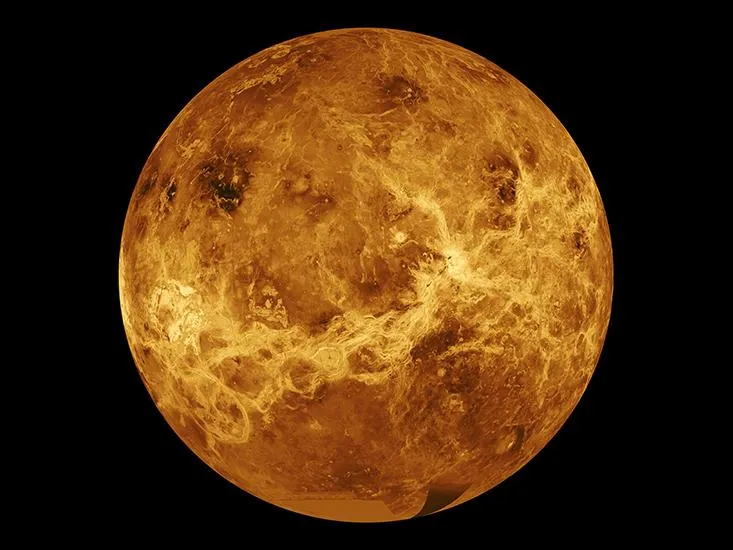A Giant Planetary Smashup May Have Turned Venus Hot and Hellish
A collision with a large object may have triggered changes deep inside the planet that ultimately affected its atmosphere
/https://tf-cmsv2-smithsonianmag-media.s3.amazonaws.com/filer/84/7b/847b74ad-f782-4800-8999-64f1561b3da5/artist_s_concept_of_lightning_on_venus.jpg)
Despite its hellish conditions today, Venus may once have been a welcoming world. It's just a bit smaller than Earth, and if water arrived at both planets the same way, Venus could have once hosted oceans on its surface. At some point, however, its atmosphere took off in a runaway greenhouse effect, and now surface temperatures are hot enough to melt lead.
Planetary scientists have been trying to figure out what happened to poor Venus to trigger this dramatic transformation. Now simulations have offered an intriguing—if still very early—theory: Venus developed its stifling atmosphere following a collision with a Texas-sized object.
Cedric Gillmann of the Royal Observatory of Belgium and his colleagues simulated what would happen if various sized objects crashed into Venus. They found that immediate effects, such as blowing part of the atmosphere into space, made only small changes that the planet could quickly recover from. But a significant impact could have driven changes deep within the mantle that could have changed the geology and atmosphere of the planet over hundreds of millions of years, especially if it occurred when Venus was relatively young.
"There are some periods of time when a large impact can be enough to switch a cool surface to a hot surface and change the history of the planet," Gillmann says.
According to their models, if a spherical object between 500 and 1,000 miles wide hit Venus, energy from the colliding object would have heated the upper mantle enough to melt it. That melted portion would have risen to the surface, spreading into a long, shallow layer just beneath the crust. Water and carbon dioxide within the mantle could then be released to the surface as gases, which could have caused a significant shift in the planet's atmosphere.
If Venus suffered an impact early enough in its lifetime, water released from the mantle could have then been stripped away by the stronger solar wind streaming from a more active young sun, leaving behind a drier planet. With the bulk of the planet's water pulled from the mantle early on, little would be left to become trapped in the atmosphere once solar activity calmed down. The resulting dense atmosphere, rich in carbon dioxide, would help to dramatically heat the planet, the team reports in the April issue of Icarus.
"A large collision is going to affect not just the formation of large craters on the surface, but it may also affect the atmosphere through a range of processes," says Simone Marchi of the Southwest Research Institute in Colorado, was not involved in the research. "[The new study] focuses on an effect that perhaps has not been fully investigated in the past—what happens precisely to the internal evolution of the planet."
Impacts of objects of this size are rare. According to other studies, bodies roughly the size of the dwarf planet Ceres, which is 590 miles wide, crash into planets approximately once in their lifetime. Larger objects are even rarer.
"No such impacts should have happened in the last 3 billion years or so," Gillmann says. Still, we know that the early solar system went through a period called the Late Heavy Bombardment, when fragments of protoplanets smashed into the rocky worlds near the sun, leaving scores of craters. And there's plenty of evidence Earth suffered a significant collision in its youth. Scientists think that a Mars-sized body slammed into our planet, carving out the material that formed the moon.
So why didn't Earth wind up with a super-greenhouse effect? The colliding object is estimated to be far larger—around 4,000 miles wide. Such a drastic impact would have completely removed and reformed Earth's surface, essentially allowing it to be reset. On Venus, however, the crust would have remained intact, with only a small portion of the mantle allowed to leak out into the planet's atmosphere.

If a massive impact really did scar Venus enough to change its atmosphere, other effects aren't readily apparent. The planet's surface is fairly young, covered up with lava that could have come from an impact or from its once active volcanoes. But there are more indirect clues. The planet has a strangely slow rotation—a day on Venus is longer than its year—and it spins backwards compared to the rest of the planets in the solar system.
Previous studies have suggested that Venus's strange spin could have been caused by a major impact. Still, a significant impactor isn't the only way to heat up the planet's atmosphere. Volcanoes erupting over the course of billions of years could also have funneled carbon dioxide from the mantle to the surface, heating the planet over its history.
Marchi adds that he would like to have seen more detailed estimates on the amounts and composition of the gases removed from the various collisions, factors which would depend on when in the history of the planet an impact occurred.
"This is a very fundamental process not just for Venus, but for all the terrestrial planets," he says.
One of the biggest difficulties in creating more detailed models comes from the fact that we have very little data to work with. While Mars has received a slew of robotic visitors over the past 40 years, Earth's "evil twin" has garnered much less attention.
"At the moment, we simply do not have a lot of information on the history of Venus, which could help us find out evidence of an impact," Gillmann says. "We hope that further missions and observations could find some areas which could be older."
/https://tf-cmsv2-smithsonianmag-media.s3.amazonaws.com/accounts/headshot/NTR_headshot.jpg)
/https://tf-cmsv2-smithsonianmag-media.s3.amazonaws.com/accounts/headshot/NTR_headshot.jpg)